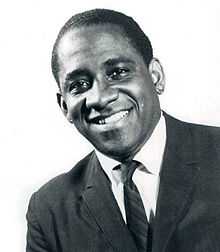Afro Blue
"Afro Blue" is a jazz standard composed by Mongo Santamaría, perhaps best known in its arrangement by John Coltrane.
Santamaria version

Mongo Santamaria first recorded his composition "Afro Blue" in 1959.[1]
Rhythm
"Afro Blue" was the first jazz standard built upon a typical African 3:2 cross-rhythm, or hemiola.[2] The song begins with the bass repeatedly playing 6 cross-beats per each measure of 12/8, or 6 cross-beats per 4 main beats—6:4 (two cells of 3:2). The following example shows the original ostinato "Afro Blue" bass line. The slashed noteheads indicate the main beats (not bass notes), where you would normally tap your foot to "keep time."

While the bass sounds the six secondary beats, Paul Horn's flute solo and Emil Richards' marimba solo emphasize the four primary beats. Francisco Aguabella takes the conga drum solo on the first recording, quoting phrases from the vocabulary of the abakuá bonkó drum.
Using brushes, Willie Bobo plays an abakuá bell pattern on a snare drum. This cross-rhythmic figure divides the twelve-pulse cycle into three sets of four pulses. Since the main beats are grouped as four sets of three pulses (dotted quarter-notes in the top example), the bell pattern significantly contradicts the meter. Bobo played this same pattern and instrumentation on the Herbie Hancock jazz-descarga "Succotash."[3]
Harmony
The harmonic structure of Santamaria's version is a simple Bb pentatonic blues.
Coltrane version
Rhythm
In 1963 John Coltrane recorded "Afro Blue" with Elvin Jones on drums.[4] Jones took the opposite approach of Santamaria, superimposing two cross-beats over every measure of a 3/4 jazz waltz (2:3). This particular swung 3/4 is perhaps the most common example of overt cross-rhythm in jazz.[5][6] Coltrane and Jones reversed the metric hierarchy of Santamaria's composition, by performing in 3/4 swing (2:3), instead of 6/8 or 12/8 (3:2). See: Demonstration of 2:3 cross-rhythm in 3/4 jazz waltz.
Coltrane's version of "My Favorite Things, also uses a 3/4 jazz waltz rhythm.
Harmony
Coltrane added several chords, making his version more harmonically sophisticated than Santamaria's original version.
References
- ↑ "Afro Blue," Afro Roots (Mongo Santamaria) Prestige CD 24018-2 (1959).
- ↑ Peñalosa, David (2010). The Clave Matrix; Afro-Cuban Rhythm: Its Principles and African Origins p. 26. Redway, CA: Bembe Inc. ISBN 1-886502-80-3.
- ↑ "Succotash" Inventions and Dimensions (Herbie Hancock). Blue Note CD 84147-2 (1963).
- ↑ "Afro Blue," Impressions (John Coltrane) Pablo CD (1963).
- ↑ Conor Guilfoyle demonstrates 3/4 swing. http://www.youtube.com/watch?v=OEAyWsTLrYY&feature=related
- ↑ John Coltrane performs "Afro Blue" with Elvin Jones on drums. http://www.youtube.com/watch?v=olOYynQ-_Hw
Recorded performances
- 1959: Cal Tjader Sextet - Concert by the Sea, Part 1 (Fantasy). The first recorded performance of the piece, recorded live on April 20, 1959, at the Sunset Auditorium in Carmel, California, with composer Mongo Santamaría on percussion.
- 1959: Mongo Santamaría - Mongo (Fantasy), recorded the following month with his own band, which was nevertheless released prior to the above recording.
- 1959: Abbey Lincoln - Abbey Is Blue (Riverside). First recording with lyrics by Oscar Brown Jr.. On the original LP sleeve it was credited to Herbie Mann.
- 1963: John Coltrane - Live at Birdland (Impulse!, 1964)
- 1963: John Coltrane - Afro Blue Impressions (Pablo Live, 1977)
- 1965: Clare Fischer - Manteca! (Pacific Jazz, 1965)
- 1965: John Coltrane - Live in Paris (Impulse!, 1971)
- 1965: John Coltrane - Live in Seattle (Impulse!, 1971)
- 1966: John Coltrane - Live in Japan (Impulse!, 1973). "At 38:49, [...] the longest [version] Coltrane ever recorded."
- 1968: Rahsaan Roland Kirk - Volunteered Slavery (Atlantic, 1969), as part of a Coltrane-tribute, framed by "Lush Life" and "Bessie's Blues".
- ca. 1968 The Ace of Cups - eventually released on It's Bad for You But Buy It (Big Beat 2003)
- 1970: Jean Pace(/Oscar Brown, Jr./Sivuca) - Joy (RCA Victor)
- 1972: Rahsaan Roland Kirk - Brotherman in the Fatherland (Rhino, 2006)
- 1973: McCoy Tyner - Song of the New World (Milestone)
- 1974: Dee Dee Bridgewater - Afro Blue (Trio)
- 1976: Shigeharu Mukai - Favorite Time (Teichiku)
- 1981: Michel Petrucciani - Date with Time (Owl), the track here is attributed to John Coltrane, maybe as intended reference.
- 1991: Dianne Reeves - I Remember (Blue Note)
- 1992: Momo Wandel Soumah - Matchowe (and Momo le doyen, 2007)
- 1994: John McLaughlin - After the Rain (Verve)
- 1996: Conrad Herwig – The Latin Side of John Coltrane (Astor Place)
- 1997: Andy Summers' The Last Dance of Mr. X (BMG Classics)
- 1997: McCoy Tyner Plays John Coltrane: Live at the Village Vanguard (Impulse!, 2001)
- 1998: McCoy Tyner and the Latin All-Stars (Telarc)
- 1998: Gov't Mule - Live... With a Little Help from Our Friends (Capricorn)
- 2000: Dianne Reeves - In the Moment - Live in Concert (Blue Note)
- 2002: Susana Baca - Espiritu Vivo (Luaka Bop)
- 2003: Lizz Wright - Salt (Verve)
- 2003: David Garfield - Retro Jazz Quintet (DVD, Aix)
- 2003: Derek Trucks Band - Soul Serenade (Columbia) and 2009 on Roadsongs (Masterworks)
- 2004: New Santana Band - Hymns for Peace (DVD, Eagle Rock Entertainment, 2007)
- 2006: Stephane Wrembel - Barbes Brooklyn (CD Baby)
- 2006: Candida Rose - KabuMerikana: The Sum of Me (CDBY)
- 2009: Jason Ricci - Done With The Devil (Electo Groove)
- 2009: The Derek Trucks Band - Roadsongs (Masterworks, 2010)
- 2010: Borgore - Borgore Ruined Dubstep (Buygore)
- 2012: Robert Glasper featuring Erykah Badu - Black Radio (Blue Note)
- 2012: Alex & Nilusha - Moments in Time (The Planet Company/MGM)
- 2013: Mansfield High School Percussion Ensemble - Performed in their 2013 WGI PSCO Program "Sketches of a Latin Groove".
